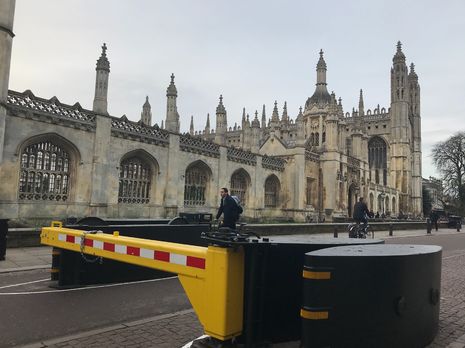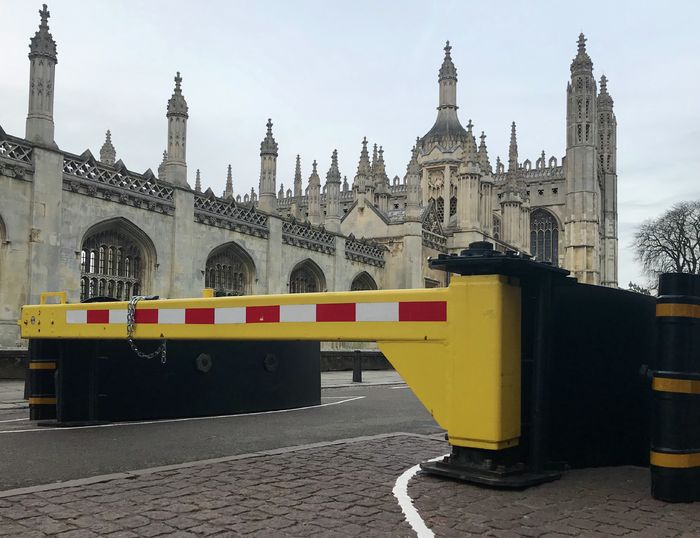Are we missing more insidious politics behind the King’s Parade anti-terror barrier?
Isobel Duxfield encourages us to recognise that the new anti-terror barrier represents much more than just an ugly mark across the beloved King’s parade.

You may not have noticed, but King’s Parade has acquired some new furniture. Actually, the new 3-metre anti-terror barricade is impossible to miss. The bright yellow swing gate bisects the street, straddled by huge concrete blocks, striking a peculiar contrast to Cambridge’s historic architecture. Feng Shui this is not.
The brainchild of Cambridge City Council, the Greater Cambridge Partnership and Cambridgeshire Constabulary, the barrier is designed to prevent unscreened vehicles accessing the street. The measures were prompted by safety concerns in popular tourist areas following a succession of fatal and horrific vehicle attacks in Nice, New York and Strasbourg which exposed the vulnerability of crowded urban spaces to attack.
However, the £70,000 barrier has not proved popular amongst many residents and business owners. Described as a “clumsy blot” and a “Monstrous carbuncle”, a petition to have it removed has now passed 1000 signatures.
“Military style urban security extends beyond the overt armaments like that on King’s Parade.”
Cyclists are particularly peeved. The barrier has turned navigating King’s Parade into a game of Mario Kart. Leaving just 1.2 metres for bikes to pass, cyclists must dodge past one another like Princess Peach on Rainbow Road, but without the fun, psychedelic colours. Cambridge Cycling Campaign have voiced their objections to the obstruction and lack of community consultation, warning the barrier in fact creates the exact crowds a terrorist might seek to target.
Yet, while criticism has focused on aesthetics, budgets and practical concerns, it overlooks a more ominous politics signalled by the installation of this fortification.
Cambridge’s barrier is indicative of our preoccupation with securitising the city in the post 9/11 era. Following terror attacks in London, Nice, Boston and elsewhere, cities have been transformed by military style technologies aiming to protect against insurgency. Overnight, barriers have sprung up in “vulnerable” sites across the UK; from huge concrete blocks on London Bridge, to bright yellow bollards in Birmingham.
Meanwhile, across the pond in New York, Mayor, Bill de Blasio, has earmarked $103 million for permanent barriers, bollards and granite blocks to ‘defend’ the Big Apple. As such conspicuous security amplifies, cities become limitless battlespaces and militarised security measures leave us perpetually anticipating the invisible assailant.
“Anti-terror architecture is woven into our cities.”
Military style urban security extends beyond the overt armaments like that on King’s Parade. Following an upsurge in urban terrorism in the 1990’s, our cities became punctuated by an architecture of terror. Indeed, London boasts a ‘Ring of Steel’, a heavily surveilled, invisible frontier designed to protect its financial centre. Strategically positioned bollards, one-way roads and heavily fortified flower planting produce a hidden urban fortress within the streetscape.
Anti-terror architecture is woven into our cities. Urban spaces are replete with systems of camouflaged surveillance and barrier technology, stalking and manipulating our movements.
These constructions reflect the UK’s wider preoccupation with counter terror measures. Over the last few decades, we have seen a torrent of new - and highly invasive - anti-terror legislation, extending stop and search powers and increasing sentences. From full body scanners which virtually strip air passengers, to repeated announcements on trains, we live in an age of defensive vigilance, where individual civil liberties are conceded in defending the state against immanent strikes.
This is not to dismiss the very real threat of attack which appears to have heightened over the last few years. Experiences on London Bridge and in Nice, which have had devastating consequences for members of Cambridge’s community, reveal the horrors of such terror strikes. Councillor Lewis Herbert is correct in asserting our community “deserves” this safeguard.
However, the King’s Parade barrier does not deliver the “protection” Herbert heralds. For starters, the barricade is only in action between 9:30 and 19:00 - are we to assume that terrorists don’t operate beyond daylight hours? Not to mention, the high-security gate appears to be protected by what has been described as a “pretty low-tech five-digit combination lock costing about £60 from a hardware store.”
Jokes aside, the unattractive edifice is detrimental to our community. The barrier is not so much intended as a material defence than a means of fostering constant vigilance against an eternally immanent attack. This breeds an alarming culture of fear and hostility, which has legitimised counter-terror policies which disproportionately discriminate against religious and ethnic minorities. Indeed, as human rights group, Cage, have shown, security procedures like those found at airport security are not only ineffective, they are systematically Islamophobic. Partnered with recent growing nationalist and anti-immigration rhetoric, such measures perpetuate an ugly and dangerous xenophobia and racism.
Cambridge City Council have emphasised that the anti-terror barrier is a temporary measure, promising a rigorous consultation process before a more permanent solution is found. Though, judging by similar constructions in other cities, the King’s Parade barrier is likely to be a permanent feature.
In the meantime, we need to decide what kind of city we want to live in. The possibility of a terror attack must be taken seriously, but does such a threat really warrant this siege mentality? Defence must not come at the cost of the community Cambridge has taken so long to build. Walling off our city with makeshift barriers cannot be the answer.
 Comment / The (Dys)functions of student politics at Cambridge19 January 2026
Comment / The (Dys)functions of student politics at Cambridge19 January 2026 News / Local business in trademark battle with Uni over use of ‘Cambridge’17 January 2026
News / Local business in trademark battle with Uni over use of ‘Cambridge’17 January 2026 Arts / Exploring Cambridge’s modernist architecture20 January 2026
Arts / Exploring Cambridge’s modernist architecture20 January 2026 Features / Exploring Cambridge’s past, present, and future18 January 2026
Features / Exploring Cambridge’s past, present, and future18 January 2026 News / Your Party protesters rally against US action in Venezuela19 January 2026
News / Your Party protesters rally against US action in Venezuela19 January 2026








